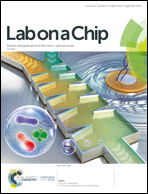Formation of precisely composed cancer cell clusters using a cell assembly generator (CAGE) for studying paracrine signaling at single-cell resolution†
Abstract
The function and behaviour of any given cell in a healthy tissue, or in a tumor, is affected by interactions with its neighboring cells. It is therefore important to create methods that allow for reconstruction of tissue niches in vitro for studies of cell–cell signaling and associated cell behaviour. To this end we created the cell assembly generator (CAGE), a microfluidic device which enables the organization of different cell types into precise cell clusters in a flow chamber compatible with high-resolution microscopy. In proof-of-concept paracrine signalling experiments, 4-cell clusters consisting of one pancreatic β-cell and three breast cancer cells were formed. It has previously been established that extracellular ATP induces calcium (Ca2+) release from the endoplasmic reticulum (ER) to the cytosol before it is cleared back into the ER via sarcoplasmic/ER Ca2+ ATPase (SERCA) pumps. Here, ATP release from the β-cell was stimulated by depolarization, and dynamic changes in Ca2+ levels in the adjacent cancer cells measured using imaging of the calcium indicator Fluo-4. We established that changes in the concentration of cytosolic Ca2+ in the cancer cells were proportional to the distance from the ATP-releasing β-cell. Additionally, we established that the relationship between distance and cytosolic calcium changes were dependent on Ca2+-release from the ER using 5-cell clusters composed of one β-cell, two untreated cancer cells and two cancer cells pretreated with Thapsigargin (to deplete the ER of Ca2+). These experiments show that the CAGE can be used to create exact cell clusters, which affords precise control for reductionist studies of cell–cell signalling and permits the formation of heterogenous cell models of specific tissue niches.

- This article is part of the themed collection: Lab on a Chip Recent Open Access Articles


 Please wait while we load your content...
Please wait while we load your content...